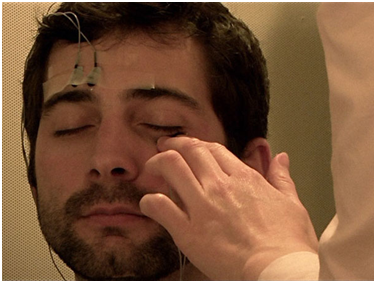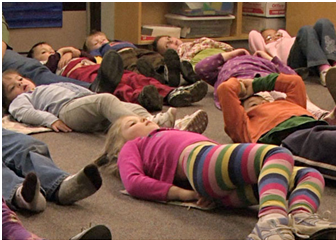
Time slows down. Fear takes hold. Trauma takes grips the brain, hijacks the mind. The brain’s first job is to protect us from danger. Sometimes it gets overloaded and fear takes up residence in our bodies. Trauma afflicts and limits. How can we understand these phenomena? How can we free ourselves from the negative effects of trauma? These questions are explored in the new film, “Free the Mind” by acclaimed Danish filmmaker, Phie Ambo.
This is a beautiful and compelling film. The take home lessons of the film could be summarized in a few lines. Veterans who take a seven-day mindfulness course see a reduction the PTSD symptoms and improvements in their sleep. A young child who learns mindfulness is able to overcome his fear of elevators. Beyond these take aways, we get an intimate look inside the lives of two veterans, Steve and Rich and the young boy named Will.
We get to experience the raw fear that Steve still experiences and we get to hear about the things he did in the war that he has trouble living with. We get to hear Rich speaking about the horrific events that he witnessed in Iraq. We get to see five-year-old Will, diagnosed with attention deficit hyperactivity disorder (ADHD), falling into emotion when thinking about an elevator. We get to see a mindfulness for kids class and all the wonderful techniques used with children, like breathing buddies. We get to see the kids practicing mindfulness and developing emotional intelligence.
The familiarity captured in the film is remarkable, as if there were no cameras present. Phie points out that when the situations in your life are compelling, as they were for the people featured in the film, the camera disappears into the background. The emotional drama within takes center stage.
Phie came to mindfulness because she was experiencing a disturbance in her life and did not want to pursue a pharmacological solution. This is a common route for many people. For example, the world renown meditation teacher, S. N. Goenka learned mindfulness meditation after traditional medicine could not relieve his crippling migraines. Seven years ago, Phie developed panic attacks and tried a Mindfulness-Based Stress Reduction program (MBSR). She has been meditating ever since and is an advocate of continued practice. As she underwent this transformation, she wondered what was really going on inside of her, especially in the brain. Did she get beyond her panic attacks because she was motivated to change or did something change in her brain? She started to research the neuroscience of meditation and found Dr. Richard Davidson. Thus, Free the Mind was born.
The film has a powerful contemporary classical musical score by Johan Johannsson that is expansive, lyrical, and poignant. Phie also does the cinematography for the film. She captures the sense of confinement that fear brings and the spaciousness that mindfulness promises. The film also features custom animation that captures the chaos and fluidity of the brain. These images are gripping and inspired by actual neuroscience images but are artistic renditions that add dimensionality to the film.
The film will likely be an integral part of the Mindfulness Revolution. Just as the PBS series Healing and the Mind that featured Jon Kabat-Zinn was a boon to the movement twenty years ago, this film will increase the public profile of mindfulness. It lets us know in a compelling and gentle way that mindfulness can help with fear. It can help us to move from the imprisonment of our memories to the openness of breathing.
I had an opportunity to speak with both Dr. Davidson and Phie Ambo about the making of the film. Dr. Davidson, or “Richie” as he is affectionately known and I spoke about the voluminous research currently being conducted at the Waisman Center at the University of Wisconsin--Madison. He directs sixty staff who are engaged in dozens of neuroscience research projects that are investigating the basic science of mindfulness, including how meditation may affect gene expression as well as ongoing investigation of the functional and structural changes of the brain linked to meditation. Other studies are looking at how meditation may impact inflammation in a beneficial way. There are large studies being conducted with mindfulness for children, from preschool through middle school. That study is being funded by the Bill and Melinda Gates Foundation.
The research featured in Free the Mind is one of the several studies investigating veterans. The particular study shown in the film was a seven consecutive day intervention that featured yogic breathing (pranayama). Other studies are looking at more traditional length (that is, eight weeks) mindfulness-based programs. These programs include a martial arts component that is not part of the typical MBSR course. It is not yet known what the optimal format is and the data will be available in about a year from now.
The integration of martial arts for the veteran population is an example of upaya—skillful means. Upaya is an adaptive approach that seeks to make the benefits of mindfulness available. We see it happen in this work with veterans and with kids. There is a long tradition of upaya, stretching all the way back to the Buddha’s original teaching. He was known for his ability to tailor his message to the audience receiving it, whether farmers or kings. He often used metaphors, parables, and stories to illustrate his teachings. To find out more about Dr. Davidson’s work, you can visit the Investigating Healthy Minds Website.
Richie met His Holiness the Dalai Lama in 1992 and this changed his life and the trajectory of mindfulness research. The studies coming out of the Waisman Center and other labs around the country have provided objective data on the benefits of mindfulness meditation. Being able to see and measure something gives it credibility in medical and scientific circles. These studies are not seeking to validate Buddhism as some critics have erroneously charged (see the Winter 2012 Issue of Tricycle Magazine feature articles on the “Scientific Buddha” and my letter to the editor entitled “Out of Context” in response to these articles). The Mindfulness Revolution has moved a quantum leap forward thanks to Richie’s pioneering work.
Free the Mind opens at the Rubin Museum in New York City on May 3 with a sold out performance. There will be additional screenings Monday, May 6, 3pm; Wednesday, May 8, 7pm; Thursday, May 9, 3 pm; Friday, May 10, 9:30 pm. It is also premiering in Toronto and Vancouver. Free the Mind goes on tour and hits Madison, Dallas, Santa Fe, Williamsburg, Seattle, Claremont, Palo Alto, Los Angeles, Santa Monica, Pasedena, and Hartford. For more information visit the film’s website.
Arnie Kozak, Ph.D., is a Mindfulness-Based Psychotherapist, author, and speaker. He is a Clinical Assistant Professor of Psychiatry, University of Vermont College of Medicine. He leads workshops at the Barre Center for Buddhist Studies and the Kripalu Center for Yoga and Health. Read more from Dr. Kozack on his Beliefnet blog, Mindfulness Matters.


